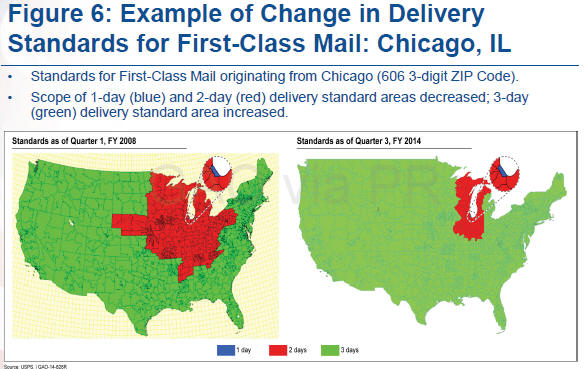U.S. Postal Service: Information on Recent Changes to Delivery Standards, Operations, and Performance
What GAO Found
The U.S. Postal Service (USPS) revised its delivery standards, which has generally increased delivery time for some First-Class Mail and Periodicals from 1 day to 2 days, notably by reducing mail with a 1-day standard.USPS also revised its delivery standards for 2-day delivery. Mail must now be within a 6-hour drive between the applicable processing facilities rather than within a 12-hour drive time to meet the 2-day delivery standard; mail sent outside the 2-day delivery area shifted to a 3-day delivery standard. USPS estimated that about one quarter of First-Class Mail volume was affected by these changes. USPS also eliminated 1-day delivery standards for some Periodicals, which generally shifted to a 2-day standard.
USPS’s changes in delivery standards enabled it to make significant operational changes, including closing some mail processing facilities. USPS stated that as a result, there are fewer facilities, and less need to rely on air transportation of mail between facilities to meet the 2-day delivery standard. As a result, USPS shifted long-distance transportation of some mail from air to surface transportation. USPS also moved the deadline for entering some bulk business mail to earlier in the day and took actions intended to balance its workload, notably by increasing the delivery time of some Standard Mail from 3 to 4 days.
National delivery performance trends between the beginning of fiscal year 2011 and the third quarter of fiscal year 2014 varied for the following types of mail: First-Class Mail, Standard Mail, and Periodicals. National performance for single-piece First-Class Mail with 1-day, 2-day, and 3-5 day delivery standards was generally improving until the second quarter of fiscal year 2013, then leveled off or declined, with 3-5 day performance declining throughout fiscal year 2014.
National delivery performance for bulk First-Class Mail for 1-day, 2-day, and 3-5 day delivery standards improved in fiscal 2012, but generally declined throughout fiscal year 2014. Generally, performance for four types of Standard Mail improved with exceptions in the third quarter of fiscal year 2013 and the second quarter of fiscal year 2014 when all four types declined. National delivery performance for Periodicals has fluctuated in recent years (ranging from about 69 percent in fiscal year 2012 to 82 percent in fiscal year 2013), with the most recent performance levels similar to those in fiscal year 2011 (about 80 percent so far in fiscal year 2014 to 76 percent in fiscal year 2011).
Why GAO Did This Study
Since 2012, USPS has instituted several initiatives aimed at reducing expenses in its mail delivery and processing networks as part of broader efforts to address its fiscal challenges and move toward financial viability. These initiatives included changing the mail delivery standards for some types of mail and then consolidating many mail processing operations and facilities. GAO was asked to review these changes and how they may have affected mail delivery performance. This report describes (1) changes to delivery standards starting in 2012 and how they affected the number of days it takes for mail to be delivered, (2) operational changes USPS has made starting in 2012 and how these may have affected delivery time, and (3) trends in delivery performance starting in fiscal year 2011. GAO reviewed USPS’s rules and regulations that define its delivery standards and operational changes, other relevant reports from USPS, the Postal Regulatory Commission, and USPS’s Federal Register notices about its operational changes and changes to its delivery standards. GAO compared mail delivery performance and volume data before and after delivery standard changes, from fiscal years 2011 through the third quarter of fiscal year 2014.
What GAO Recommends
GAO is not making any recommendations in this report.
For more information, contact Phillip Herr at 202-512-2834 or herrp@gao.gov.

we were told of this plan. result at plant is total job abolishment, rebid,14 excess, all done by january 15.
5 day delivery is here………… Sign me up!
Thanks everybody!!…your customers
Last one out turn out the lights, please… If you work in any profession that deals with printed matter, it’s just a matter of time… Technology has taken over, like it or not… The percentage of the system abusers, entitlement addicted, nurtured by non-compromising labor unions, have had a serious drain on this antiquated network… Good luck to all those with the stones to stick it out… Seriously,,, good luck…
So much for the saying ‘the mail must go through’.[no matter how slow}
Let’s thank the Republican’s for losing good paying jobs and paying retirement benefits to the tune of $5.5 billion that is already funded to Congress so they can have pay raises for doing nothing
Only in the delusional, corrupt world of postal mgmt does higher product prices and less service, equal increased revenue.
These clowns couldn’t run a lemonade stand, let alone a multibillion dollar business.
no matter the effort by upper management, no matter the party of elected officials, the truth is technology will continue to evolve and effect what the post office does and how it does it. as a recently retired union postal worker i encourage all current postal workers (union and non union) to put in an honest days work and refrain from insignificant issues that one may be tempted to involve oneself in. rather focus on the big picture that may affect you and your family as your working career moves along. I miss my fellow workers and the camaraderie we shared but in no way do i miss the incompetent effort by poor managers and their lack of common sense when dealing with people. The most important resource the postal service has it its work force. i hope they realize it someday.